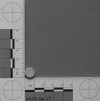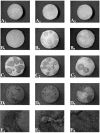In Vitro Description of Macroscopic Changes of Dental Amalgam Discs Subject to High Temperatures to Forensic Purposes
- PMID: 26851445
- PMCID: PMC5734811
In Vitro Description of Macroscopic Changes of Dental Amalgam Discs Subject to High Temperatures to Forensic Purposes
Abstract
Objective: To describe the behavior of 45 discs of dental amalgam of known dimension prepared from three commercially available brands of dental amalgam (Contour® Kerr®-USA, Admix® SDI®-Australia and Nu Alloy® Newstethic®-Colombia) when subjected to the action of high temperatures (200 °C, 400 °C, 600 °C, 800 °C, 1000 °C). It was hoped to establish parameters that could be used for human dental identification in cases of charred, burned or incinerated human remains.
Materials and methods: A pseudo-experimental descriptive in-vitro study was designed to describe the macroscopic physical changes to the surface of 45 discs of pre-prepared amalgam of three commercially available brands exposed to a range of high temperatures.
Results: Characteristic and repetitive physical changes were a noticeable feature of the discs of amalgam of each brand of amalgam subjected to the different temperature ranges. These physical changes included changes in dimensional stability, changes in texture, changes in colour, changes in the appearance of fissures and cracks and changes in the fracture and fragmentation of the sample.
Conclusions: The characteristics of dental amalgam may be of assistance in cases of human identification where charred, burned or incinerated human remains are a feature and where fingerprints or other soft tissue features are unavailable.
Conflict of interest statement
The authors declare that they have no conflict of interest.
Figures



References
-
- Rothwell BR. Principles of dental identification. Dent Clin North Am. 2001;45:253–70. - PubMed
-
- Norrlander AL. Burned and incinerated remains, In Bowers CM, Bell GL (ed.). Manual of Forensic Odontology, 3th edition. Colorado Springs. American Society of Forensic Odontology; 1997.
-
- Sweet D. Why a dentist for the identification? Dent Clin North Am. 2001;45:237–51. - PubMed
-
- Pretty IA, Sweet D. A look at forensic dentistry. Part 1: The role of teeth in the determination of human identity. Br Dent J. 2001;190:359–66. - PubMed
Publication types
MeSH terms
Substances
LinkOut - more resources
Full Text Sources
Research Materials
